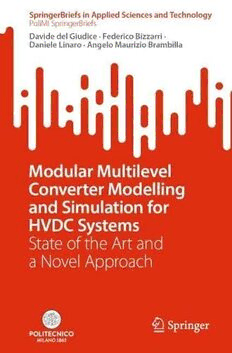
Modular Multilevel Converter Modelling and Simulation for HVDC Systems: State of the Art and a Novel Approach PDF
Preview Modular Multilevel Converter Modelling and Simulation for HVDC Systems: State of the Art and a Novel Approach
SpringerBriefs in Applied Sciences and Technology PoliMI SpringerBriefs Davide del Giudice · Federico Bizzarri · Daniele Linaro · Angelo Maurizio Brambilla Modular Multilevel Converter Modelling and Simulation for HVDC Systems State of the Art and a Novel Approach SpringerBriefs in Applied Sciences and Technology PoliMI SpringerBriefs SeriesEditors BarbaraPernici,PolitecnicodiMilano,Milan,Italy StefanoDellaTorre,PolitecnicodiMilano,Milan,Italy BiancaM.Colosimo,PolitecnicodiMilano,Milan,Italy TizianoFaravelli,PolitecnicodiMilano,Milan,Italy RobertoPaolucci,PolitecnicodiMilano,Milan,Italy SilviaPiardi,PolitecnicodiMilano,Milan,Italy Springer,incooperationwithPolitecnicodiMilano,publishesthePoliMISpringer- Briefs,concisesummariesofcutting-edgeresearchandpracticalapplicationsacrossa widespectrumoffields.Featuringcompactvolumesof50to125(150asamaximum) pages, the series covers a range of contents from professional to academic in the followingresearchareascarriedoutatPolitecnico: (cid:129) AerospaceEngineering (cid:129) Bioengineering (cid:129) ElectricalEngineering (cid:129) EnergyandNuclearScienceandTechnology (cid:129) EnvironmentalandInfrastructureEngineering (cid:129) IndustrialChemistryandChemicalEngineering (cid:129) InformationTechnology (cid:129) Management,EconomicsandIndustrialEngineering (cid:129) MaterialsEngineering (cid:129) MathematicalModelsandMethodsinEngineering (cid:129) MechanicalEngineering (cid:129) StructuralSeismicandGeotechnicalEngineering (cid:129) BuiltEnvironmentandConstructionEngineering (cid:129) Physics (cid:129) DesignandTechnologies (cid:129) UrbanPlanning,Design,andPolicy · · Davide del Giudice Federico Bizzarri · Daniele Linaro Angelo Maurizio Brambilla Modular Multilevel Converter Modelling and Simulation for HVDC Systems State of the Art and a Novel Approach DavidedelGiudice FedericoBizzarri DepartmentofElectronics,Information DepartmentofElectronics,Information andBioengineering andBioengineering PolitecnicodiMilano PolitecnicodiMilano Milan,Italy Milan,Italy DanieleLinaro AngeloMaurizioBrambilla DepartmentofElectronics,Information DepartmentofElectronics,Information andBioengineering andBioengineering PolitecnicodiMilano PolitecnicodiMilano Milan,Italy Milan,Italy ISSN 2191-530X ISSN 2191-5318 (electronic) SpringerBriefsinAppliedSciencesandTechnology ISSN 2282-2577 ISSN 2282-2585 (electronic) PoliMISpringerBriefs ISBN 978-3-031-12817-2 ISBN 978-3-031-12818-9 (eBook) https://doi.org/10.1007/978-3-031-12818-9 ©TheAuthor(s),underexclusivelicensetoSpringerNatureSwitzerlandAG2023 Thisworkissubjecttocopyright.AllrightsaresolelyandexclusivelylicensedbythePublisher,whether thewholeorpartofthematerialisconcerned,specificallytherightsoftranslation,reprinting,reuse ofillustrations,recitation,broadcasting,reproductiononmicrofilmsorinanyotherphysicalway,and transmissionorinformationstorageandretrieval,electronicadaptation,computersoftware,orbysimilar ordissimilarmethodologynowknownorhereafterdeveloped. Theuseofgeneraldescriptivenames,registerednames,trademarks,servicemarks,etc.inthispublication doesnotimply,evenintheabsenceofaspecificstatement,thatsuchnamesareexemptfromtherelevant protectivelawsandregulationsandthereforefreeforgeneraluse. Thepublisher,theauthors,andtheeditorsaresafetoassumethattheadviceandinformationinthisbook arebelievedtobetrueandaccurateatthedateofpublication.Neitherthepublishernortheauthorsor theeditorsgiveawarranty,expressedorimplied,withrespecttothematerialcontainedhereinorforany errorsoromissionsthatmayhavebeenmade.Thepublisherremainsneutralwithregardtojurisdictional claimsinpublishedmapsandinstitutionalaffiliations. ThisSpringerimprintispublishedbytheregisteredcompanySpringerNatureSwitzerlandAG Theregisteredcompanyaddressis:Gewerbestrasse11,6330Cham,Switzerland Preface Modular multilevel converters (mmcs) have evolved as the technology of choice in high voltage direct current (hvdc) systems, which nowadays are increasingly adoptedtoconnectasynchronousacgridsandefficientlytransmitpoweroverlarge distances.Thedistinctivefeatureofthemmcisthepresenceofastackofuptoseveral hundreds of identical submodules (sms) in each of its arms. On the one hand, this modularstructuregrantsthe mmcreducedswitchinglossesandscalabilitytohigh voltage and power ratings, thus making it a popular technology in hvdc systems. Ontheotherhand,themmctopologyanditscomplexcontrolschemeposeseveral challengesinstandardpowersystemsimulatorstasks. One of these challenges, namely the electromagnetic transient (emt) simula- tionof mmcs,isthecoretopicofthisbook.Inessence,themultitudeofcascaded smsineacharmimpliesthatmanyelectricalnodes(unknowns)andsemiconductor devices must be evaluated simultaneously while simulating. Thus, simulations of mmc-based hvdc systems lead to a high computational burden if conventional emtsimulationtoolsand mmcmodelsareadopted.Toreduce cputimes,scholars proposedseveralmmcmodelsthatrelyonsimplersmrepresentationsandimplement different trade-offs between simulation speed and accuracy. Despite successfully reducing the computational burden, these models are incompatible with thorough mmc-basedac/dcnetworksimulations,whichmayrequireadetailedtransistor-level representationofthesemiconductordevicesinthesms. Inthisframework,thepurposeofthisbookistwofold.First,itprovidesacompre- hensivereviewandcomparisonofthemmcmodelsdevelopedintheliteratureover theyears.Second,itproposesanovelandefficientmmcsimulationapproachbased onsub-circuitisomorphism.Thistechnique,whichhasitsrootsinthefieldofelec- tronics, can be profitably exploited to efficiently simulate mmcs regardless of the modelusedtodescribeitssms,includingthemostaccurateones. Thebookisstructuredasfollows. (cid:129) Chapter1introducestheissuescurrentlywitnessedintheelectricitysectordue totheincreasingpenetrationofrenewableenergysourcesandhvdcsystemsand highlightsthekeyroleofelectricpowersystemsimulationinthiscontext. v vi Preface (cid:129) After a brief overview of different multilevel converter technologies proposed inthelastdecades,Chap.2focusesonthemmcbydescribingitsmostrelevant propertiesandatypicalcontrolarchitecture.Then,themainchallengesposedby mmcsfromapowersystemsimulationandanalysisperspectivearesummarised. (cid:129) Chapter3presentsthemainmodelsavailableintheliteraturetosimulatemmcs and describes the simulation approach based on sub-circuit isomorphism. Each solutionisdescribedintermsofthedegreeofretainedaccuracy,computational burdenincurred,andthemostsuitabletypesofanalysesthatitcancarryout. (cid:129) The isomorphism-based approach is validated in Chap. 4 by exploiting a well- knownhvdcbenchmarksystemcomprisingtwommcs.Thebenchmarkissimu- latedinawidearrayofscenarios,rangingfromnormaloperatingconditionsto acanddc-sidefaults,toshowcasethekeyfeaturesoftheproposedapproach. (cid:129) Lastly,Chap.5providessomeclosingremarks. ThebooklargelydrawsfromthePh.D.thesisinElectricalEngineering“Simula- tionandAnalysisofModularMultilevelConvertersBasedonIsomorphismandPeri- odicSmall-signalAnalysis”byDavidedelGiudice;supervisors:FedericoBizzarri, tutors:DanieleLinaroandAngeloMaurizioBrambilla,PolitecnicodiMilano,2022. In particular, some of the results presented in the book appeared in the following publication: D. del Giudice, A. Brambilla, D. Linaro, and F. Bizzarri, Isomorphic CircuitClusteringforFastandAccurateElectromagneticTransientSimulationsof mmcs,IEEETransactionsonEnergyConversion,2022. Due to its educational content, this book constitutes a useful guide for Ph.D. studentsandresearchersinterestedinthetopicof mmcsandtheirsimulation.Italso servesasastartingplatformforjuniorelectricalengineerswhoworkinthefieldof powerelectronicconvertersforhvdcsystems. Milan,Italy DavidedelGiudice January2023 FedericoBizzarri DanieleLinaro AngeloMaurizioBrambilla Contents 1 Introduction ................................................... 1 1.1 ChallengesofRenewablesinElectricPowerSystems ............ 3 1.1.1 DistributedEnergyResources .......................... 5 1.1.2 ConcentratedEnergyResourcesandtheRoleofhvdc systems ............................................. 6 1.2 RationaleoftheBook ....................................... 7 1.3 Notation .................................................. 9 References ..................................................... 9 2 Modular Multilevel Converters: Key Features, Control StrategiesandMainChallenges .................................. 11 2.1 Converter Technologies for High Voltage and Power Applications ............................................... 11 2.1.1 Two-LevelVoltageSourceConverters ................... 12 2.1.2 DiodeClampedConverters ............................ 14 2.1.3 ActiveNeutralPointClampedConverters ............... 17 2.1.4 FlyingCapacitorConverters ........................... 19 2.1.5 CascadedH-bridgeConverters ......................... 20 2.2 ModularMultilevelConverters ............................... 21 2.3 ThemmcControlStrategy ................................... 28 2.3.1 ParkTransformation .................................. 29 2.3.2 Phase-LockedLooppll ............................... 32 2.3.3 UpperLevelControls ................................. 33 2.3.4 LowerLevelControls ................................. 37 2.3.5 Protections .......................................... 42 2.4 Challenges ................................................ 43 2.4.1 PowerFlow ......................................... 43 2.4.2 Initialization ........................................ 44 2.4.3 StabilityAnalysis .................................... 45 2.4.4 ElectromagneticTransientSimulation ................... 46 References ..................................................... 47 vii viii Contents 3 Modular Multilevel Converter Models and Simulation Approaches .................................................... 51 3.1 LiteratureReviewof mmcModelsforTransientSimulations ..... 52 3.1.1 FullPhysics(fp)Model ............................... 54 3.1.2 FullDetailed(fd)Model .............................. 55 3.1.3 Bi-valueResistor(bvr)Model ......................... 56 3.1.4 ThéveninEquivalentModel(tem) ..................... 57 3.1.5 SwitchingFunctionModel(sfm) ....................... 63 3.1.6 AverageValueModel(avm) ........................... 68 3.2 Isomorphism-BasedSimulationTechniques .................... 71 3.2.1 PrinciplesofIsomorphism ............................. 73 3.2.2 IsomorphicSimulationof mmc ........................ 75 3.2.3 Main Features and Fields of Application oftheIsomorphism-BasedSimulationof mmcs .......... 80 References ..................................................... 82 4 ValidationoftheIsomorphism-BasedApproach ................... 85 4.1 SimulationSetting .......................................... 85 4.1.1 acGridsandTransformers ............................ 85 4.1.2 dcLine ............................................. 87 4.1.3 mmcParameters ..................................... 94 4.1.4 Details Concerning Full-Physics, Full-Detailed, andBi-valueResistorSubmoduleModels ............... 95 4.1.5 SimulatedScenarios .................................. 98 4.2 SimulationResults .......................................... 99 4.2.1 AnalysisofSimulationAccuracy ....................... 99 4.2.2 AnalysisofSubmodulesVariables ...................... 105 4.2.3 AnalysisofSimulationSpeed .......................... 107 References ..................................................... 114 5 Conclusion .................................................... 117 Chapter 1 Introduction Abstract Thisintroductorychapterpresentsthechallengescurrentlyposedinthe electricity sector due to the increasing penetration of distributed and concentrated Renewable Energy Sources (ress), as well as high voltage direct current (hvdc) systems.Inthiscontext,electricpowersystemsimulationiscrucial,sinceitallows assessingtheimpactoftheseelementsatdifferentstages,suchasthedesignphase andreal-timeoperation.However,modernsimulatorsarenotcapableofefficiently simulating the power electronics converters typically employed as grid interfaces forressandhvdcsystems.Asaresult,commercialsimulatorsneedtobeupdated by implementing more advanced simulation and computational techniques. After summarisingtheseissues,thechapter introducesthetechnology thisbookfocuses on:themodularmultilevelconverter. Nowadays, the concept of energy is at the heart of many interconnected chal- lengesthattheworldisfacing.Theso-calledglobalenergychallengeindicatesthat two actions are essential to ensure sustainable development for all: guaranteeing universalaccessanduseofenergy,aswellasenforcingproperenergyresourceman- agement,whichlimitsenvironmentalimpactandpreventsconflictsandinequalities. TheAgenda2030,anactionplansignedinSeptember2015bytheworldleaders,pro- posed17SustainableDevelopmentGoals(sdgs),showingthepathtobefollowed towards sustainable development for the whole world. In particular, energy has a prominentroleintheseventhsdg,whosemissionis:“Ensureaccesstoaffordable, reliable,sustainableandmodernenergy forall”.Thisgoalcomprises fivetargets, oneofwhichpromotesasubstantialincreaseintheshareofressintheglobalenergy mix.Thepursuitofthisspecifictargetimpliesthatalsotheelectricitysectorwillkeep onchanginginthefuture. Inrecentyears,theintegrationofresshasbecomemoreandmoreevidentworld- wide. For instance, consider Fig.1.1, which shows the percentage share of global electricitygenerationbyenergysourcein1973and2019[1].Specifically,thepen- etration of non-hydro ress and waste (e.g., geothermal, solar, wind, and biofuels) hasincreasedby10.2%from1973to2019.Amongothers,thistrendisgivenbythe progressivedeploymentofwindandphotovoltaicenergysourcesreportedinFig.1.2, whichisfosteredbypoliciesandsupportmechanisms,suchasFeed-InTariffs[2]. ©TheAuthor(s),underexclusivelicensetoSpringerNatureSwitzerlandAG2023 1 D.delGiudiceetal.,ModularMultilevelConverterModellingandSimulation forHVDCSystems,PoliMISpringerBriefs, https://doi.org/10.1007/978-3-031-12818-9_1
